INTRODUCTION
This exhibition, the first detailed survey of traditional armor
and weapons from the Tibetan plateau, comprises material from
The Metropolitan Museum of Art and a handful of other museums,
most in Great Britain. Until recently, these objects were understood
to represent only a few generic types and were dismissed as archaic
and simplistic. A more careful appraisal, however, reveals a far
wider and surprisingly nuanced variety of styles, decorative techniques,
materials, dates, and cultural influences that have been previously
unknown or simply overlooked.
The Tibetan plateau, the world’s highest, covers an area
roughly the size of Western Europe and is legendary for its elevation
and remoteness. Armor and weapons are certainly not what come
to mind when considering Tibet, which is identified with the pacifism
and deep spirituality of the Dalai Lama and with the compassionate
nature of Tibetan Buddhism. This seeming paradox, however, is
resolved in the context of Tibetan history, which included regular
and extended periods of intense military activity from the seventh
to the mid-twentieth century. After becoming largely obsolete
in the West, many types of weapons, such as matchlock muskets,
swords, spears, and archery equipment, remained practical in Tibet
and were in regular use well into the twentieth century. Armor
for man and horse was in limited military use by the end of the
nineteenth century but was preserved both in regional arsenals
and for important ceremonial occasions, such as the Great Prayer
Festival held annually in the Tibetan capital of Lhasa. Historical
armor and weapons also survive due to the long-standing and widespread
tradition of placing votive arms in monasteries and temples, where
they are kept in special chapels known as gonkhang (mgon khang)
and dedicated to the service of a guardian deity.
The primary goal in presenting this material is to call attention
to its existence, with the hope that the variety, complexity,
and craftsmanship of armor and weapons from Tibet may begin to
be appreciated as yet another facet of its rich and enduring culture.

Decorative Materials and Techniques
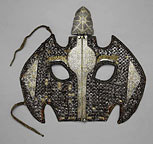
Head Defense
for a Horse
|
|
Iron and leather, the primary structural materials used to decorate
arms and armor from Tibet, are frequently used in combination
with gold, silver, copper alloys, and wood, and often incorporate
turquoise, coral, yak hair, and various textiles. The techniques
employed to decorate objects made principally of iron include
damascening, inlay, engraving with gold and silver, pierced work,
chiseling, and embossing; they can be used alone but are frequently
combined.
Damascening (also called overlay) is by far the most
common technique used on iron in Tibet. It is done by scoring
or crosshatching an iron surface with a pattern of fine lines,
usually within the borders of an engraved design. Gold or silver
wires are laid over the cross-hatching and rubbed with a burnishing
tool to adhere them to the iron ground. Wires laid side by side
and properly burnished can produce the effect of a continuous
sheet of gold or silver.
Inlay involves inserting gold, silver, or copper wires
into grooves engraved into the surface of the iron. True inlay,
however, is rarely found on Himalayan ironwork, as damascening
was the preferred technique.
Engraving consists of incising a design into a metal
surface using punches, chisels, or other specialized tools.
| |
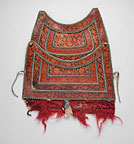
Breast Defense
|
Mercury gilding (also called fire gilding) is frequently
used for applying a thin layer of gold to objects made of silver,
bronze, or copper alloys, but seems not to occur before the late
nineteenth or early twentieth century on Tibetan objects made
of iron. In mercury gilding, a paste (called an amalgam) made
from gold mixed with mercury is applied to a metal surface that
has been coated with a thin layer of copper or copper sulfate.
The surface is then heated until the mercury evaporates, which
fixes the gold. In a relatively rare variation on this technique,
an iron surface is damascened with a layer of silver and then
mercury gilding is applied over it.
Pierced work refers to intricately pierced patterns
created in an iron surface with punches and files. It is used
on relatively flat panels and on complex surfaces such as saddle
plates and is often combined with chiseling and damascening.
Leatherwork includes painted and tooled leather and
leather appliqués. Most impressive, however, is the use
of gold leaf and pigmented shellacs applied over leather to simulate
the appearance of lacquer, which is employed to great effect on
horse armor, leather arm defenses, and bow cases and quivers.

Symbols and Iconography

Set of Saddle
Plates
|
|
The degree of ornamentation and the range of symbols found on
Tibetan arms and armor can vary considerably, but generally the
same decorative motifs that appear in other Tibetan objects and
works of art, such as furniture, ritual implements, sculpture,
and paintings, are seen on arms and armor. While these motifs
can have deep religious or iconographic significance, on secular
objects they usually serve simply as protective and auspicious
symbols and as signs of Buddhist piety.
The most prevalent form of decoration consists of scrollwork,
which can range from leafy tendrils to stylized clouds and flame
patterns. Scrollwork may be the only design, but it more often
serves as the background for other motifs, particularly dragons,
which are perhaps the single most frequently used subject. Nearly
as popular as the dragon is a type of monster mask known in Tibetan
as tsi pa ta or by its Sanskrit name, kirttimukha. It is found
throughout Tibet, China, India, and Indonesia, where it is used
as a sign of good fortune and to ward off evil. A closely related
motif has a similar mask joined to the body of a winged creature
that represents the khyung, or garuda, a mythical bird that protects
against serpents and illness.
| |
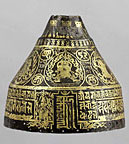
Helmet
|
Other important and frequently encountered designs derive from
the Eight Auspicious Symbols: endless knot, lotus, umbrella, conch
shell, wheel, victory banner, vase, and pair of golden fish. These
can appear individually or in groups, as central design features
or as subtle accents on virtually any type of Tibetan object,
from the most humble utilitarian item to the most elaborate ritual
item or painting. Another common motif resembles a flaming jewel
that generally takes one of three forms: three distinct orbs representing
the Three Jewels; a cluster of elongated shapes representing the
Precious or Wish-fulfilling Jewel; and a single flaming jewel
or pearl. Other popular subjects are the thunderbolt (rdo rje,
or vajra), swastika, and whirling emblem. The less common symbol
of dry skulls is associated with ritual offerings to the wrathful
deities.
A more unusual but highly evocative type of decoration on armor
and weapons is lettering. It usually takes the form of Lantsa
(also called Ranjana), an ornamental alphabet derived from ancient
Indian scripts that is used for sacred texts, and individual symbolic
letters called seed syllables, or bija. In a few instances, more
conventional Tibetan scripts are incorporated into decoration
or used for inscriptions.

Lamellar Armor and Helmets

Armor and
Helmet
|
|
Lamellar armor is made of horizontal rows of small overlapping
plates joined by leather lacing. The basic features that distinguish
this type of armor are that the lamellae, or plates, are supported
by being laced only to one another, rather than to a lining or
support material of any kind, and that the rows of lamellae always
overlap upward. Lamellae were made of leather, bronze, and iron.
Lamellar armor perhaps originated in the ancient Near East as
early as the eighth century b.c. Iron lamellar armor was known
in China as early as the third century B.C., in Central Asia probably
around the same time, and in Western Europe by the fifth or sixth
century A.D. Given this long period of use over such a widespread
geographical area, it is remarkable that the armors found in Tibet
constitute nearly all the examples in existence of lamellar armor
made of iron that do not come from an archaeological context.
| |

Armor and Helmet
|
Most Tibetan lamellar armors share several features. The body
of the armor has the form of a sleeveless robe made from twelve
to fourteen or more rows of lamellae, and the coat has a distinct
waist, with the lamellae being bent in a subtle curve. Some armors
have shoulder defenses formed of several rows of lamellae, and
at least one has full sleeves. The coat opens down the length
of its front, and the back of the skirt is split vertically from
the bottom row up to the waist by two seams, one at either side.
Some are trimmed with borders made of silk brocade that are attached
around the bottom edge of the coat at the base of the skirts and
at the bottom of the shoulder defenses. The majority have a simple
border at the base of the skirts consisting of two layers of thick
leather.
Equally distinctive helmets were made to match the armors and
are likewise associated only with Tibet or the Tibetan cultural
region. These helmets are constructed of iron plates joined by
leather laces. The bowl of the helmet is usually made of eight
arched plates, with four narrow outer plates that have cusped
edges and four wider inner plates that have smooth edges. In addition
to a characteristic plume finial at the top of the helmet, complete
examples also have a single row of lamellae encircling the base
of the bowl, a pair of cheek defenses made of five to seven rows
of lamellae, and a flaring nape defense of three rows.

Helmets
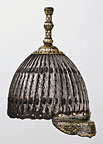
Multiplate
Helmet
|
|
The two principal forms of helmets from Tibet are the eight-plate
lamellar helmet and a cavalry helmet with a one-piece hemispherical
bowl and upturned fabric flaps, usually considered Bhutanese but
adapted for use in Tibet. In recent years, several other types
have emerged that represent various important but little-known
styles that reflect the influence in Tibet of Mongolia, China,
and Central and western Asia. These include two distinct kinds
of rare multiplate helmets, made of many narrow lames laced or
riveted together, which have their roots in the early nomadic
cultures of the steppe but were probably introduced into Tibet
by the Mongols (cat. nos. 9–13). Another rare type, probably
Mongol, has a one-piece hemispherical bowl with a cylindrical
apex (cat. no. 14). A later and better-known Mongol helmet style
has a stepped bowl made of two or three fitted conical segments
(cat. nos. 15, 16). What became the classic helmet style of China
during the Qing dynasty is represented by two early examples from
Tibet that may be late Ming or early Qing (cat. nos. 19, 20).
A few of the helmets are so unusual as to have almost no stylistic
parallels but suggest influences from Central and western Asia
(cat. nos. 21–23).
The majority of the decorative motifs are derived from Tibetan
Buddhism. They range from simple depictions of the Three Jewels
(cat. no. 14), to complex arrangements of deities and mantras
(cat. no. 16), to an elegant image of the Buddha Shakyamuni (cat.
no. 19).

Shields
Although they generally have been overlooked in the little that
has been written on the subject, shields appear to have been widely
used in Tibet. They were invariably round and of two basic types:
those of cane or wicker and those of leather. The cane shields
seem to have been made in Tibet, while most, if not all, the leather
examples appear to come from India, Bhutan, Sikkim, and probably
Nepal. The cane shields have two principal forms: flat (cat. no.
24) and domed or convex (cat. no. 25).
Domed cane shields were used over a wide geographical area, from
China to the Middle East. In profile, the Chinese examples are
the most deeply domed, the Tibetan ones are less so, and the Middle
Eastern style is only slightly convex. In terms of construction
and aesthetics, the type culminated with Ottoman cane shields
of the sixteenth and seventeenth centuries, the best examples
of which are finely made and have exteriors that are delicately
embroidered in silk and sometimes beautifully painted. Domed cane
shields in Tibet can be completely plain or have varying degrees
of painted decoration. They have a small central iron boss and
a single handle in the center of the back. The large flat cane
shield may have been indigenous to Tibet and perhaps was more
prevalent in western Tibet, judging by the examples found there
and in Ladakh. These have a peaked iron boss in the center from
which a series of iron struts radiate.
Leather shields, sometimes made from rhinoceros hide, are hard,
strong, and relatively light. They generally have at least four
small metal bosses on the exterior that anchor the handgrips and
sometimes an arm strap on the interior. This general type, from
India and elsewhere, was probably used in the areas along Tibet’s
entire southern border.

Leather Armor
The Tibetan term for leather armor, bse khrab, combines the word
meaning “tanned leather” or “rhinoceros”
(bse) with the word for “armor” (khrab). Bse, or bse
ko, also refers specifically to varnished or dyed leather. Therefore,
bse khrab does not refer only to leather armor but also to armor
made of leather decorated in this manner, which would describe the
majority of surviving examples. The decorative technique appears
to be similar to that used on leather horse armor—a combination
of pigmented shellac and gold leaf—but differs in terms of
the choice and style of ornament.
Armor made from leather plates of various sizes and shapes was
in use in China and Central Asia from a very early period; fragments
of examples for man and horse occur at archaeological sites dating
from the Eastern Zhou period (770–256 B.C.). The earliest
examples from a Tibetan context appear to be the remains of armor
made of small squares of lacquered leather joined by leather laces
that were found by Sir Aurel Stein at Mira–n, on the southern
Silk Road in Central Asia at a site identified as a Tibetan fort
of the eighth to ninth century A.D.
Based on a limited number of carbon-14 tests, the majority of
the examples in the exhibition, like the lamellar armor and horse
armor displayed here, appear to date from the fifteenth to the
seventeenth century. All the forearm guards exhibited appear to
be for the left arm, suggesting that they were not made in pairs.
There are two basic types. The first has applied iron struts,
like those on Tibetan shields (cat. no. 24) and furniture, but
often with ornamental piercings. The second type does not have
struts or other applied iron fittings, and the leather surface
is covered with gilded and varnished decoration. The same style
and technique of decoration are found on a group of bow cases
and quivers (cat. nos. 93, 94, 95) and, in one rare instance,
on a gunpowder flask (cat. no. 109).

Horse Armor

Horse Armor
|
|
The specific form of horse armor found in Tibet exists nowhere
else and is known only from rare examples. There is no set that
is fully complete and homogenous, the closest being the armor
from the Victoria and Albert Museum, London (cat. no. 26, exhibited
near the center of the gallery). The next largest set of matching
pieces from a single horse armor is from the Royal Museum of Scotland
(cat. no. 32). After that, there are only individual elements;
the best available pieces, in terms of quality and condition,
are displayed here.
The salient features that distinguish Tibetan horse armor are
the use of iron lamellae and their combination with distinctive
panels of gilded and varnished leather. The decoration of the
leather panels has a lacquerlike appearance but is not true lacquer
in the sense of urushi. Instead, the effect appears to be achieved
through the application of layers of shellac, gold leaf, and a
glaze of tung oil. On the best examples the quality of the decoration
can be very high. The motifs include a wide array of scrollwork,
lotus and other blossoms, dragons and various mythological animals,
the Eight Auspicious Symbols, and other Buddhist imagery.
The Metropolitan Museum made five carbon-14 tests on samples
from four different elements of horse armor (cat. nos. 27, 30,
31), with the results consistently being from the early to mid-fifteenth
century to the mid-seventeenth century. This period coincides
with the last two secular monarchies in Tibet, the Rinpung (rin
spung, 1435–1565) and the kings of Tsang (1566–1641),
an era of intermittent strife and outright civil war.

Mail and Other Forms of Armor
Mail, a strong and extremely flexible type of armor, is made from
hundreds or even thousands of small interlocking iron rings. Texts
from the Yarlung dynasty (7th–9th century), during which
Tibet’s empire extended through much of Central Asia, indicate
that the Tibetans wore mail of high quality in addition to lamellar
armor, which was also well known throughout the region at the
time.
| |

Mail Shirt
|
The use of mail in Tibet in the early twentieth century is well
documented in accounts of the Younghusband Expedition (1903–4)
and in photographs of the armored cavalry participating in the
Great Prayer Festival in Lhasa during the 1930s and 1940s. In
the photographs it is usually worn with a set of “four mirrors”
(four iron disks) and an armored belt. The disks are worn on the
center of the chest, back, and under each arm and held by leather
cross-straps. Most Tibetan examples appear to have been plain
disks of polished iron (cat. no. 46), but some have engraving
and damascening (cat. nos. 43, 44), applied borders (cat. no.
42), or raised inlay (cat. no. 41). The armored belts, which are
made of as many as one hundred plates and are quite flexible,
appear to be unique to Tibet.
The other forms of armor included in the adjacent cases are related
only in having been preserved in a Tibetan context and are either
unique or one of only a few known examples of their type. Consequently,
they offer glimpses of armor styles that might otherwise have
remained completely unknown.

Swords

Sword and
Scabbard
|
|
Swords were the primary hand-held weapons in Tibet from at least
the seventh century until the early twentieth. In addition to
their utilitarian function, they could also be clear indicators
of rank and status, based on their quality or quantity of decoration.
Among the Khampas of eastern Tibet, the sword was an essential
part of male dress and remains an important element of traditional
attire. The different styles of swords found in Tibet can be distinguished
by the blade, the hilt, the scabbard, and how the sword was designed
to be worn. The sword has rich symbolic significance within Tibetan
Buddhism, particularly as the Sword of Wisdom (shes rab ral gri),
which represents the ability to cut through spiritual ignorance
and is an attribute of many deities, such as Manjushri.
| |
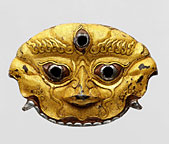
Sword Guard
|
The patterns of lines and textures that are visible on the surface
of a blade can be subtle or extremely clear. This feature is the
simplest way to distinguish traditional blades from those made
of modern iron or steel, on which these patterns are not present.
The effect is created by a technique called pattern welding, which
involves combining different types of iron or steel during the
forging process, resulting in a pattern in the finished blade.
The classic pattern, generally referred to as a hairpin pattern,
comprises gently undulating pairs of lines of alternating dark
and light colors that run the length of the blade and meet near
the tip.
Traditional Tibetan texts divide swords into five principal types,
each of which has a main subtype. These are, in turn, subdivided
into dozens of further subtypes, many of which may, however, reflect
legends and literary conventions rather than actual sword forms.

Spears and Spearheads

Spearhead
and
Ferrule
|
|
Tibetan spears fall into two basic categories: those made for
fighting and those designed for ceremonial use. The fighting spears
(cat. nos. 75, 76) generally consist of an undecorated iron spearhead
mounted on a plain wooden shaft that is reinforced by a spiraling
coil of iron wrapped around most of its length. Often there is
also an iron ferrule with a short spike at the base of the shaft.
Ceremonial spears can be divided into two general groups: those
that seem to be intended for use by oracles (cat. nos. 77, 78)
and those for other ceremonial or symbolic purposes (cat. nos.
79–84). They are made with the same materials and techniques
as the fighting spears. However, their extensive decoration, usually
gold and silver damascening, and their unsharpened edges show
that they were not intended for battle. Other spearheads displayed
here are Chinese or Mongolian, possibly for hunting spears (cat.
nos. 86–88), which were used in Tibet, and a unique shaft
socket, inscribed with Tibetan and Mongolian scripts (cat. no.
85).

Archery Equipment
| |

Quiver and
Arrows
|
Tibetan quivers and bow cases are notable for their form, construction,
and decoration. Horseback archery was a major component of warfare
in Asia, including Tibet, for fifteen hundred years or more, and
it provided much of the firepower that made the nomadic peoples
of the steppes, from the Huns to the Mongols, feared from Japan
to Western Europe. The necessity of being able to carry a bow
and a quiver of arrows for long distances on horseback, ready
for quick use in battle or the hunt, engendered a method of wearing
the bow in a sheath or case on the left hip and the quiver on
the right hip, both suspended from a waist belt. One of the earliest
quivers worn in this way has the form of a long narrow box, with
an open cowl at the top and a flared or triangular base and can
be seen in works of art from China to Iran dating from the seventh
to the fourteenth century.
Two of the few surviving examples of this rare type are displayed
here (cat. nos. 91, 92). Later and more elaborate bow cases and
quivers are made entirely of decorated leather, the same kind
of gilded and varnished leather (bse) found on leather
arm defenses and horse armor from Tibet. The bows used in Tibet
ranged from simple wooden bows to composite bows made of wood,
horn, and sinew. Arrows were made of cane or bamboo, fletched
with feathers, and fitted with arrowheads made of iron in various
shapes.

Firearms and Accessories
Firearms were probably introduced into Tibet during the sixteenth
century from China, India, and western Asia as part of the general
spread of the use of firearms throughout Asia. The traditional
Tibetan gun is a matchlock musket, known as a me mda’ (literally,
“fire arrow”), which appears to have changed little,
if at all, in its construction and technology between the time
of its introduction until the early twentieth century. Among the
most noticeable features of Tibetan matchlocks are the two long
slender prongs, or horns, that were pivoted down to rest on the
ground and steady the aim of the shooter when the gun was being
fired on foot.
The decoration on Tibetan matchlock guns varies, but even the
most utilitarian examples generally have some ornament. It is
not uncommon to find stocks with applied plaques of pierced or
embossed silver, copper, or iron that range from relatively simple
to fairly elaborate. More rarely, stocks were painted or inlaid
with bone. The match-cord pouches and pan covers often have appliqués
of colored leather or textile and decorative rivets or bosses.
The barrels are usually plain except perhaps for some fluting
at the muzzle, ring moldings toward the breech, or simple engraved
designs. There are, however, some notable exceptions of barrels
decorated with gold and silver damascening. The accessories used
with matchlock guns are designed for carrying gunpowder and bullets.
The bullets—lead balls or shot, rather than bullets in the
modern sense—were cast using small stone molds that could
be carried in a leather case attached to a waist belt.
In Europe the matchlock was primarily an infantry weapon, but
in Tibet it was also used on horseback much like the bow. As essential
military training and as part of ceremonies and festivals, riders
would shoot at targets while riding past them at a gallop. From
the seventeenth century onward, fairly realistic depictions of
matchlocks appear in paintings of offerings to the guardian deities.
The matchlock musket was primarily an essential possession of
pastoralists and nomads for hunting and personal protection, and
as such was found throughout Tibet until relatively recently.

Saddles and Bridles

Saddle
|
|
The saddles found in Tibet are a mixture of Mongol, Chinese,
and Tibetan types. The saddle consists of a wood frame called
the saddletree that is made of four parts: an arch-shaped front
and back, called the pommel and the cantle, connected by a pair
of sideboards that are tightly tied together with leather laces.
On most Asian saddles, the sideboards have short paddlelike extensions,
or end boards, in front and back. The section of the sideboards
between the pommel and the cantle where the rider would sit was
usually covered by a cushion attached by two or four ornamental
bosses. A set of saddle rugs was also often used, one on the horse’s
back underneath the saddle and one above, on the seat.
The most outstanding components of a Tibetan saddle are the metal
plates that cover the outside of the pommel, cantle, and end boards.
Although these plates reinforce the saddletree, they function
chiefly as a visible and often elaborate form of ornament and
as clear indicators of the rank, status, and importance of the
rider. They can be made of copper alloy or silver, and the finest
are done in pierced and chiseled iron, usually damascened in gold
and silver, and constitute some of the best examples of Tibetan
and Sino-Tibetan ironwork of any kind. The same is true for bridles;
the best can have delicately pierced and chiseled fittings that
rival the workmanship of the finest saddles.

Tack and Stirrups
|
|
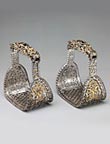
Pair of Stirrups
|
The straps that accompany a saddle are referred to as tack and include,
in addition to the bridle, the girth or cinch strap, which is usually
plain leather or a woven fabric; a breast strap across the front
of the horse’s chest; and the crupper straps, which go over
the top of the horse’s rump and have a band that passes under
the tail. When attached to a decorated saddle, the bridle, breast
strap, and crupper often have pierced-metal fittings that can be
as elaborate as those of the saddle itself.
The most immediately recognizable feature of stirrups found in
Tibet, China, and Mongolia is the nearly ubiquitous pair of dragonheads
at the top of the arch, flanking the slot for the stirrup leathers.
The stirrups are usually made of iron and can be chiseled in high
or low relief, often including pierced work, and may be extensively
damascened in gold and silver. They are composed of two posts
that form an arch over the foot and a tread on which the foot
rests. Beyond these similarities, however, there is amazing variety
in the form, decoration, and quality of stirrups from these regions.
|